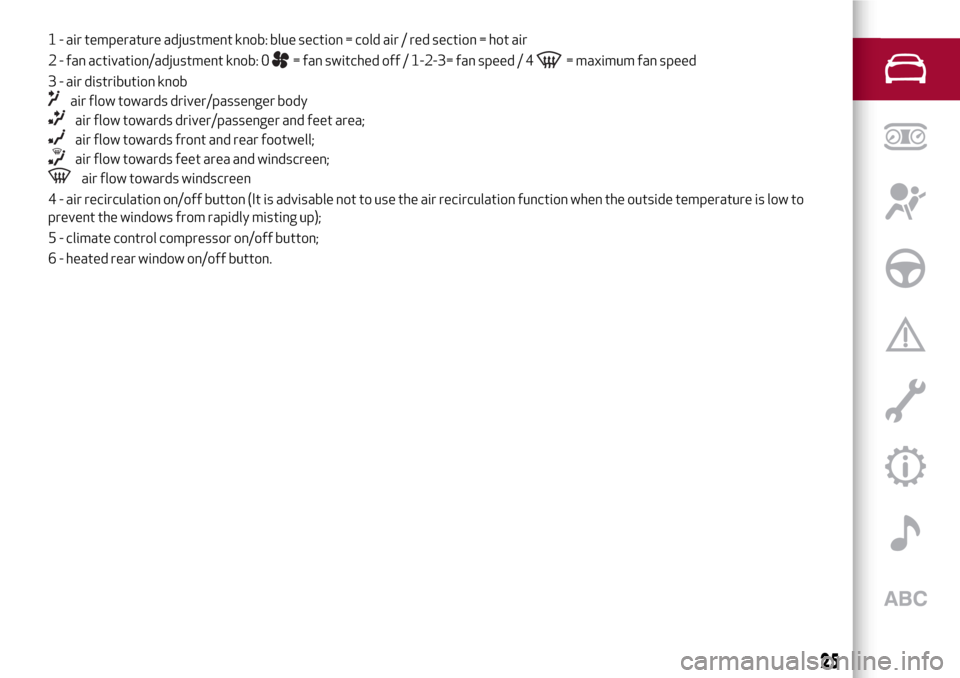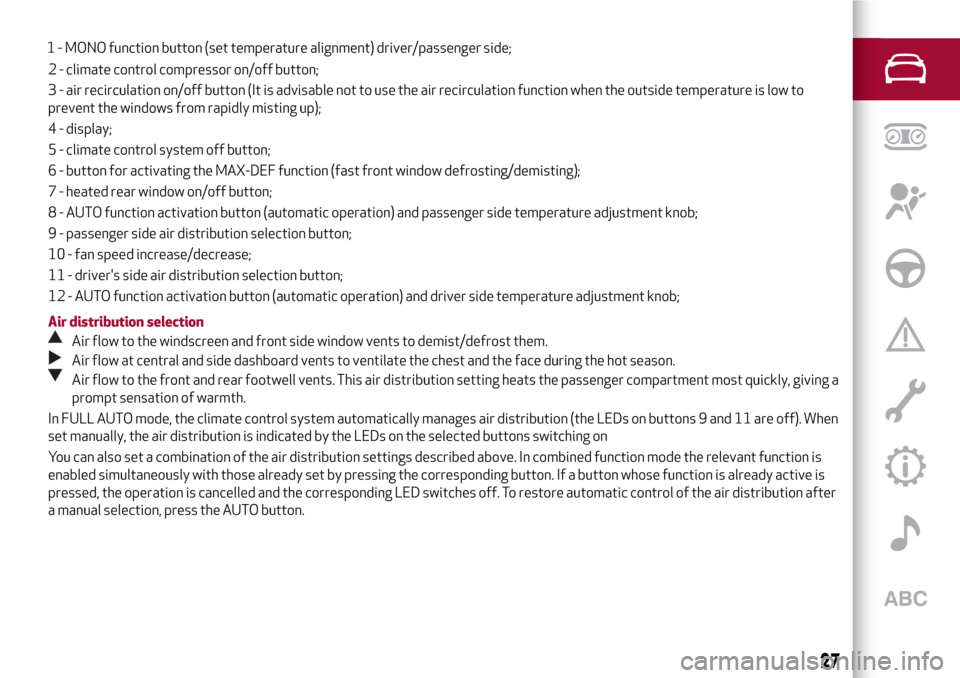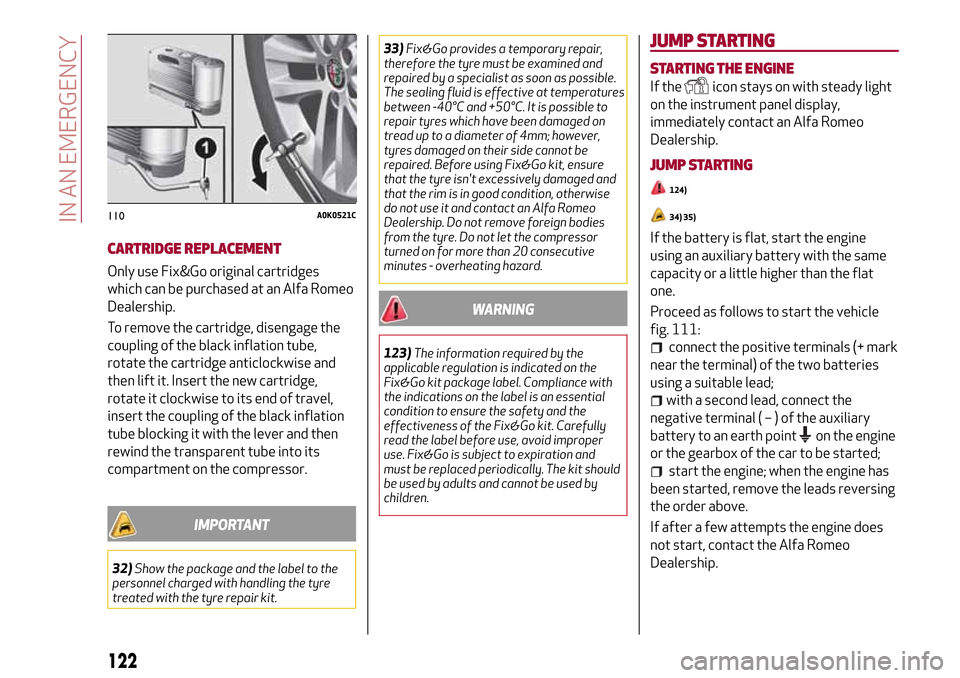2017 Alfa Romeo MiTo compre
[x] Cancel search: comprePage 27 of 212

1 - air temperature adjustment knob: blue section = cold air / red section = hot air
2 - fan activation/adjustment knob: 0
= fan switched off / 1-2-3= fan speed / 4= maximum fan speed
3 - air distribution knob
air flow towards driver/passenger body
air flow towards driver/passenger and feet area;
air flow towards front and rear footwell;
air flow towards feet area and windscreen;
air flow towards windscreen
4 - air recirculation on/off button (It is advisable not to use the air recirculation function when the outside temperature is low to
prevent the windows from rapidly misting up);
5 - climate control compressor on/off button;
6 - heated rear window on/off button.
25
Page 29 of 212

2 - climate control compressor on/off button;
3 - air recirculation on/off button (It is advisable not to use the air recirculation function when the outside temperature is low to
prevent the windows from rapidly misting up);
4 - display;
5 - climate control system off button;
6 - button for activating the MAX-DEF function (fast front window defrosting/demisting);
7 - heated rear window on/off button;
8 - AUTO function activation button (automatic operation) and passenger side temperature adjustment knob;
9 - passenger side air distribution selection button;
10 - fan speed increase/decrease;
11 - driver's side air distribution selection button;
12 - AUTO function activation button (automatic operation) and driver side temperature adjustment knob;
Air distribution selection
Air flow to the windscreen and front side window vents to demist/defrost them.
Air flow at central and side dashboard vents to ventilate the chest and the face during the hot season.
Air flow to the front and rear footwell vents. This air distribution setting heats the passenger compartment most quickly, giving a
prompt sensation of warmth.
In FULL AUTO mode, the climate control system automatically manages air distribution (the LEDs on buttons 9 and 11 are off). When
set manually, the air distribution is indicated by the LEDs on the selected buttons switching on
You can also set a combination of the air distribution settings described above. In combined function mode the relevant function is
enabled simultaneously with those already set by pressing the corresponding button. If a button whose function is already active is
pressed, the operation is cancelled and the corresponding LED switches off. To restore automatic control of the air distribution after
a manual selection, press the AUTO button.
27
1 - MONO function button (set temperature alignment) driver/passenger side;
Page 61 of 212

Symbol on the display What it means What to do
FUEL CUT-OFF SYSTEM
The display will show the symbol if the fuel cut-off
system intervenes.For the procedure to restore the fuel cut-off system see
the “Controls" paragraph in the “Knowing your vehicle”
section. If it is still not possible to restore the fuel supply,
contact an Alfa Romeo Dealership.
EXTERIOR LIGHTS FAILURE
The symbol appears on the display when there is a fault
in one of the following lights:
daytime running lights (DRL)
side lights
direction indicators
rear fog light
number plate lightsThe fault relating to these lights may be caused by: one or
more blown fuses, one or more blown bulbs or a broken
electrical connection.Check, and if necessary replace the fuses involved, in
accordance with the “Fuse replacement” paragraph, in
chapter “In an emergency”. If this does not resolve the
fault, check, and if necessary replace, the bulbs involved, in
accordance with the “External bulb replacement”
paragraph, in chapter “In an emergency”.
Should this operation also fail to resolve the fault, contact
an Alfa Romeo Dealership, for a comprehensive check of
the electrical system.
BRAKE LIGHT FAILURE
The display will show the symbol if a fault in the brake
lights is detected.The fault may be caused by a blown bulb, a blown
protection fuse or an interruption of the electrical
connection.
DUSK SENSOR FAILURE
(where provided)
The symbol appears on the display (together with a
message) in the event of dusk sensor failure.Go to an Alfa Romeo Dealership to have the fault fixed as
soon as possible.
RAIN SENSOR FAILURE
(where provided)
The symbol appears on the display (together with a
message) in the event of rain sensor failure.Go to an Alfa Romeo Dealership to have the fault fixed as
soon as possible.
PARKING SENSOR FAILURE
(where provided)
The symbol appears on the display (together with a
message) in the event of parking sensor failure.Go to an Alfa Romeo Dealership to have the fault fixed as
soon as possible.
59
Page 111 of 212

DIRECTION INDICATORS
Front
To replace the bulb, take the key 1
fig. 84 (in the document wallet), insert it
in the housing 2 and rotate the bulb
holder anticlockwise. Then extract the
bulb and replace it.
Side
To replace the bulb, proceed as follows:
press the lens 1 fig. 85 to compress in
the clip 2, then pull the cluster outwards;
turn the bulb holder 3 anticlockwise,
extract the bulb and replace it;
refit the bulb holder 3 in the lens and
turn it clockwise;
refit the cluster making sure that the
internal clip 2 clicks into position.
FRONT FOG LIGHTS
(where provided)
For replacing these bulbs, contact an Alfa
Romeo Dealership.
REAR LIGHT CLUSTERS
To access the light cluster, move the
luggage compartment side trim (see
fig. 86 ). The rear light cluster contains
the bulbs for side lights, direction
indicators and brake lights.
83A0J0040C
84A0J0018C
85A0J0042C
86A0J0043C
109
Page 115 of 212

Engine compartment junction boxfig. 91
DEVICE PROTECTEDFUSE AMPERE
Ignition deviceF03 20
Passenger compartment fanF08 40
Additional heater (Turbo TwinAir and 1.3 JTD
M-2versions)F09 5
Two-tone hornF10 15
Main beam headlightsF14 15
Additional heater (PTC 1)F15 30
Air conditioning compressorF19 7.5
Heated rear windscreen, demisting system F20 30
Electric fuel pump in tankF21 15
Front fog lightsF30 15
Additional heater (PTC2)F81 60
Additional heater (PTC1)F82 50
Additional heater (PTC2)F82 40
FreeF83 –
HI-FI sound system (control units, Bassbox speaker) mechanical gearbox setup F84 20
Power socket on tunnelF85 15
Electric door mirror demisters / Demisters on windscreen jets / Relay switch coil for heated
windscreenF87 7.5
113
Page 122 of 212

IMPORTANT
30)When turning the jack handle make sure
that it can turn freely without scraping your
hand against the ground. The moving
components of the jack ("worm screw" and
joints) can also cause injuries: avoid touching
them. If you come into contact with
lubricating grease, clean yourself
thoroughly.
31)Contact an Alfa Romeo Dealership as
soon as possible to have the correct
tightening of the wheel bolts checked.
"Fix&Go Automatic" KIT
123)
32) 33)
This is located in the boot. The kit also
contains a screwdriver and a tow hook.
The kit also contains:
bottle 4 fig. 107 containing sealant
and fitted with: filling tube 1 and
adhesive label 3 with the wording “Max.
80 km/h” to be placed in a clearly visible
position (e.g. on the dashboard) after
repairing the tyre;
compressor 2 complete with pressure
gauge and connectors;
an information leaflet, providing
instructions for using the kit correctly.
This booklet should be given to the
persons charged with handling the tyre
treated with this kit;
a pair of gloves located in the side
compartment of the compressor;
adaptors for inflating different
elements.Versions with LPG system
The car does not have a spare wheel but a
tool box fig. 108 that contains the
“Fix&Go Automatic” kit, the tow hook and
a screwdriver.
TYRE REPAIRING AND PRESSURE
RESTORING PROCEDURE
Proceed as follows:
107A0K0516C
108A0J0359C
120
IN AN EMERGENCY
place the vehicle in a safe and suitable
area, engaging the parking brake. Take
Page 123 of 212

the kit from the specific compartment;
remove the adhesive label of speed 3
(see previous paragraph) and apply it in a
visible position. Wear the protective
gloves provided;
remove the cap from the valve of the
punctured tyre and connect and firmly
tighten the transparent tube of the
sealing fluid 1 fig. 109 and tighten nut
2 on the tyre valve;
make sure that the switch for the
compressor is in position0(off), start the
engine, open the rear hatch and insert the
plug in the into the luggage compartment
power socket or on central tunnel and
start the engine. Switch on the
compressor by turning the switch to
positionI(on);
inflate the tyre to the pressure
indicated in the “Wheels” paragraph in the
“Technical data” chapter;
if after five minutes pressure is not at
least 1.8 bar/26 psi, turn off the
compressor and disconnect it from the
valve and power socket, replace the cap,
then move the vehicle forwards by
approx. ten metres in order to distribute
the sealing fluid inside the tyre evenly.
Stop the vehicle safely and repeat the
operation above until the required
pressure is reached;
if after this operation you still cannot
reach at least 1.8 bar/26 psi after
5 minutes from switching on the
compressor, THE TYRE IS TOO
DAMAGED TO BE REPAIRED. Remove
and place the kit in the specific
compartment and contact an Alfa Romeo
Dealership;
if the required pressure is reached,
restart driving. Do not exceed 80 km/h.
Avoid sudden acceleration or braking.
After driving for about 8 km / 5 miles,
place the vehicle in a safe and suitable
area, engaging the parking brake. Pick up
the kit, ensure the on-off button is in0
position, insert the electrical connector in
the vehicle 12V socket. Remove the cap
from the valve of repaired tyre,
disconnect and pull out the black inflation
tube, connect it to the valve and lock it
with the lever. Check the tyre pressure on
the pressure gauge.
if the pressure is lower than 1.8 bar /
26 psi, the TYRE IS TOO DAMAGED AND
CANNOT BE REPAIRED. Remove and
place the kit in the specific compartment
and contact an Alfa Romeo Dealership;
if the pressure indicated is equal to or
higher than 1.8 bar/26 psi, switch on the
compressor and inflate to the required
pressure. Disconnect and replace the kit
in the specific compartment. Drive
carefully to the nearest Alfa Romeo
Dealership as soon as possible.
CHECKING AND RESTORING TYRE
PRESSURE
The compressor can also be used to
check and, if necessary, restore the tyre
pressure.
Disconnect and pull out the black
inflation tube 1 fig. 110, connect and to
the tyre valve and lock in position with
the lever.
With the same procedure it is possible to
inflate bicycle tyres and balloons. The kit
should be used by adults and cannot be
used by children.
109A0K0518C
121
Page 124 of 212

CARTRIDGE REPLACEMENT
Only use Fix&Go original cartridges
which can be purchased at an Alfa Romeo
Dealership.
To remove the cartridge, disengage the
coupling of the black inflation tube,
rotate the cartridge anticlockwise and
then lift it. Insert the new cartridge,
rotate it clockwise to its end of travel,
insert the coupling of the black inflation
tube blocking it with the lever and then
rewind the transparent tube into its
compartment on the compressor.
IMPORTANT
32)Show the package and the label to the
personnel charged with handling the tyre
treated with the tyre repair kit.33)Fix&Go provides a temporary repair,
therefore the tyre must be examined and
repaired by a specialist as soon as possible.
The sealing fluid is effective at temperatures
between -40°C and +50°C. It is possible to
repair tyres which have been damaged on
tread up to a diameter of 4mm; however,
tyres damaged on their side cannot be
repaired. Before using Fix&Go kit, ensure
that the tyre isn't excessively damaged and
that the rim is in good condition, otherwise
do not use it and contact an Alfa Romeo
Dealership. Do not remove foreign bodies
from the tyre. Do not let the compressor
turned on for more than 20 consecutive
minutes - overheating hazard.
WARNING
123)The information required by the
applicable regulation is indicated on the
Fix&Go kit package label. Compliance with
the indications on the label is an essential
condition to ensure the safety and the
effectiveness of the Fix&Go kit. Carefully
read the label before use, avoid improper
use. Fix&Go is subject to expiration and
must be replaced periodically. The kit should
be used by adults and cannot be used by
children.
JUMP STARTING
STARTING THE ENGINE
If theicon stays on with steady light
on the instrument panel display,
immediately contact an Alfa Romeo
Dealership.
JUMP STARTING
124)
34) 35)
If the battery is flat, start the engine
using an auxiliary battery with the same
capacity or a little higher than the flat
one.
Proceed as follows to start the vehicle
fig. 111:
connect the positive terminals (+ mark
near the terminal) of the two batteries
using a suitable lead;
with a second lead, connect the
negative terminal(–)oftheauxiliary
battery to an earth point
on the engine
or the gearbox of the car to be started;
start the engine; when the engine has
been started, remove the leads reversing
the order above.
If after a few attempts the engine does
not start, contact the Alfa Romeo
Dealership.
110A0K0521C
122
IN AN EMERGENCY